Page 1518 of 2870
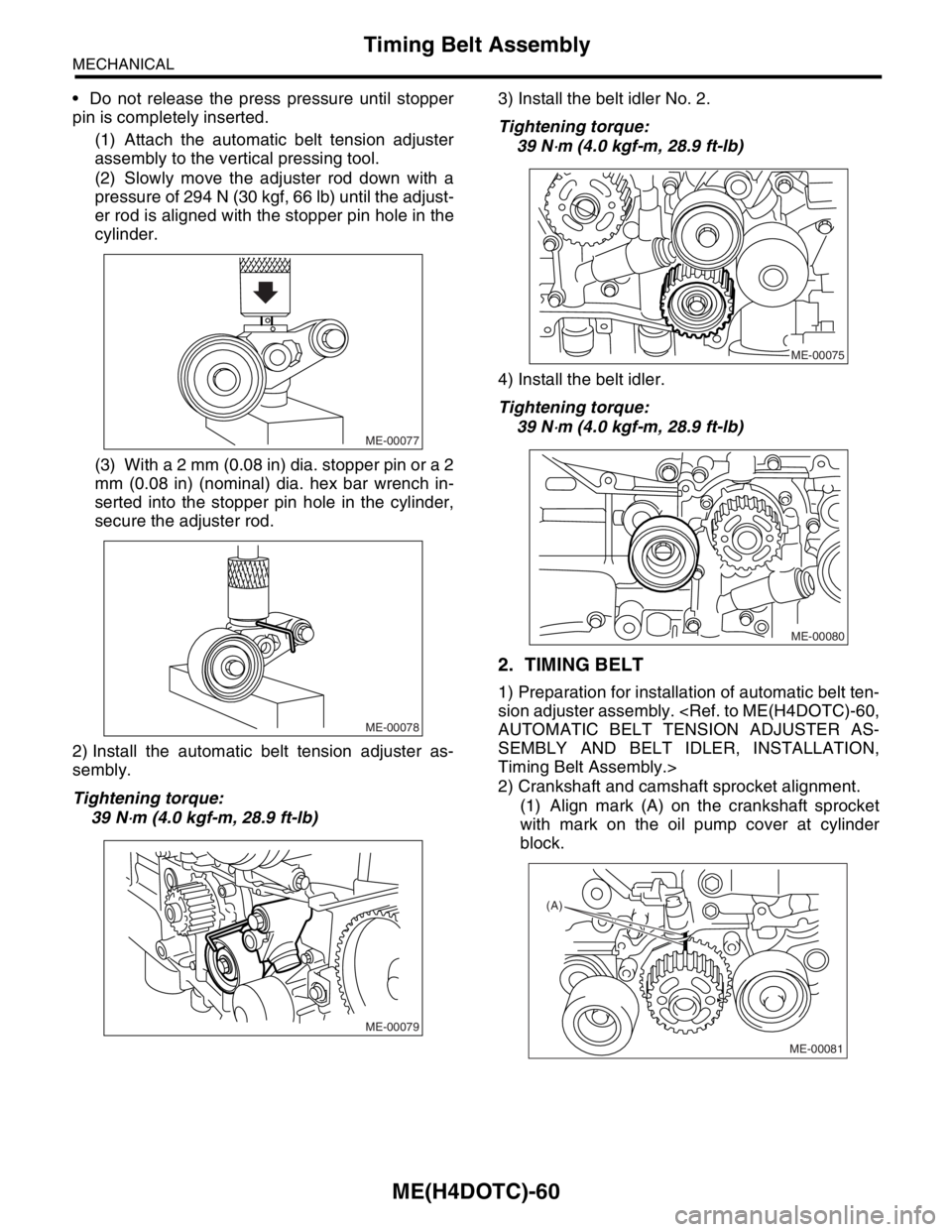
ME(H4DOTC)-60
MECHANICAL
Timing Belt Assembly
Do not release the press pressure until stopper
pin is completely inserted.
(1) Attach the automatic belt tension adjuster
assembly to the vertical pressing tool.
(2) Slowly move the adjuster rod down with a
pressure of 294 N (30 kgf, 66 lb) until the adjust-
er rod is aligned with the stopper pin hole in the
cylinder.
(3) With a 2 mm (0.08 in) dia. stopper pin or a 2
mm (0.08 in) (nominal) dia. hex bar wrench in-
serted into the stopper pin hole in the cylinder,
secure the adjuster rod.
2) Install the automatic belt tension adjuster as-
sembly.
Tightening torque:
39 N
⋅m (4.0 kgf-m, 28.9 ft-lb)3) Install the belt idler No. 2.
Tightening torque:
39 N
⋅m (4.0 kgf-m, 28.9 ft-lb)
4) Install the belt idler.
Tightening torque:
39 N
⋅m (4.0 kgf-m, 28.9 ft-lb)
2. TIMING BELT
1) Preparation for installation of automatic belt ten-
sion adjuster assembly.
AUTOMATIC BELT TENSION ADJUSTER AS-
SEMBLY AND BELT IDLER, INSTALLATION,
Timing Belt Assembly.>
2) Crankshaft and camshaft sprocket alignment.
(1) Align mark (A) on the crankshaft sprocket
with mark on the oil pump cover at cylinder
block.
ME-00077
ME-00078
ME-00079
ME-00075
ME-00080
(A)
ME-00081
Page 1519 of 2870
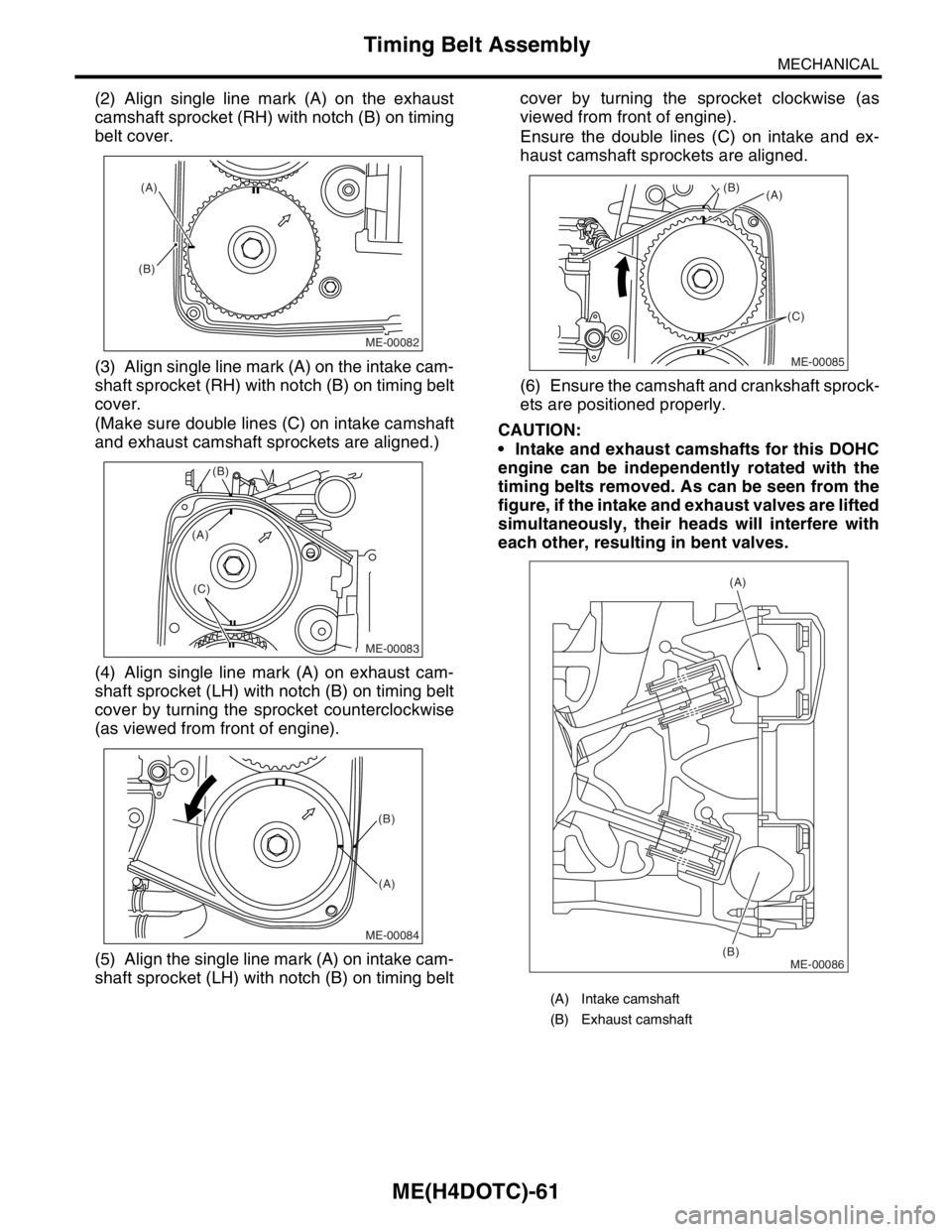
ME(H4DOTC)-61
MECHANICAL
Timing Belt Assembly
(2) Align single line mark (A) on the exhaust
camshaft sprocket (RH) with notch (B) on timing
belt cover.
(3) Align single line mark (A) on the intake cam-
shaft sprocket (RH) with notch (B) on timing belt
cover.
(Make sure double lines (C) on intake camshaft
and exhaust camshaft sprockets are aligned.)
(4) Align single line mark (A) on exhaust cam-
shaft sprocket (LH) with notch (B) on timing belt
cover by turning the sprocket counterclockwise
(as viewed from front of engine).
(5) Align the single line mark (A) on intake cam-
shaft sprocket (LH) with notch (B) on timing beltcover by turning the sprocket clockwise (as
viewed from front of engine).
Ensure the double lines (C) on intake and ex-
haust camshaft sprockets are aligned.
(6) Ensure the camshaft and crankshaft sprock-
ets are positioned properly.
CAUTION:
Intake and exhaust camshafts for this DOHC
engine can be independently rotated with the
timing belts removed. As can be seen from the
figure, if the intake and exhaust valves are lifted
simultaneously, their heads will interfere with
each other, resulting in bent valves.
ME-00082
(A)
(B)
ME-00083
(B)
(C)
(A)
ME-00084
(B)
(A)
(A) Intake camshaft
(B) Exhaust camshaft
ME-00085
(A) (B)
(C)
ME-00086
(A)
(B)
Page 1520 of 2870
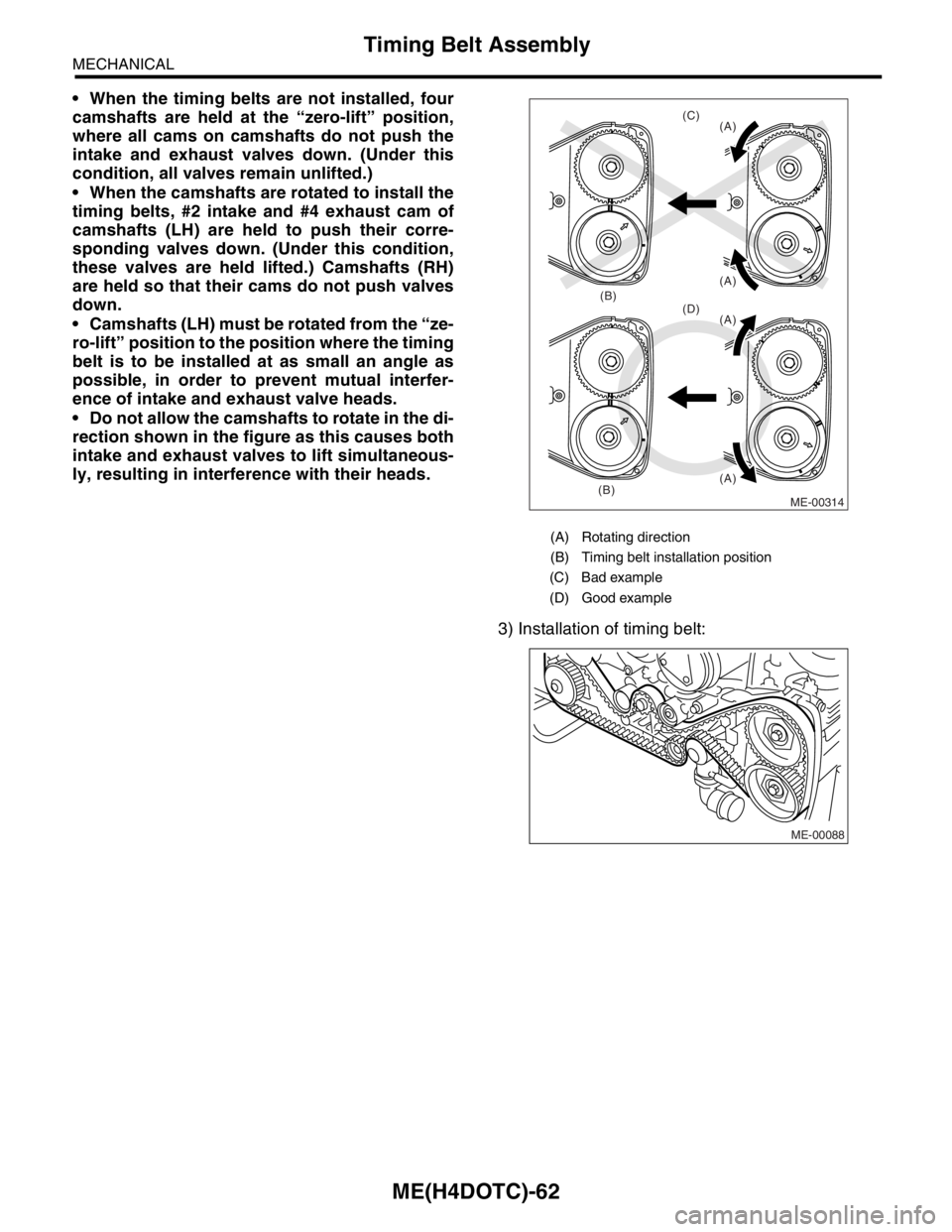
ME(H4DOTC)-62
MECHANICAL
Timing Belt Assembly
When the timing belts are not installed, four
camshafts are held at the “zero-lift” position,
where all cams on camshafts do not push the
intake and exhaust valves down. (Under this
condition, all valves remain unlifted.)
When the camshafts are rotated to install the
timing belts, #2 intake and #4 exhaust cam of
camshafts (LH) are held to push their corre-
sponding valves down. (Under this condition,
these valves are held lifted.) Camshafts (RH)
are held so that their cams do not push valves
down.
Camshafts (LH) must be rotated from the “ze-
ro-lift” position to the position where the timing
belt is to be installed at as small an angle as
possible, in order to prevent mutual interfer-
ence of intake and exhaust valve heads.
Do not allow the camshafts to rotate in the di-
rection shown in the figure as this causes both
intake and exhaust valves to lift simultaneous-
ly, resulting in interference with their heads.
3) Installation of timing belt:
(A) Rotating direction
(B) Timing belt installation position
(C) Bad example
(D) Good example
(A) (A) (A) (A)
(D) (C)
(B)(B)
ME-00314
ME-00088
Page 1521 of 2870
ME(H4DOTC)-63
MECHANICAL
Timing Belt Assembly
Align the alignment mark on timing belt with marks on sprockets in alphabetical order shown in the figure.
While aligning marks, position the timing belt properly.
CAUTION:
Disengagement of more than three timing belt teeth may result in interference between the valve
and piston.
Ensure the belt’s rotating direction is correct.
4) Install the belt idlers.
Tightening torque:
39 N
⋅m (4.0 kgf-m, 28.9 ft-lb)
NOTE:
Make sure that the marks on the timing belt and
sprockets are aligned.
5) After ensuring that the marks on the timing belt
and sprockets are aligned, remove the stopper pin
from tensioner adjuster.
(1) Arrow mark (4) 54.5 tooth length (7) Install it in the end
(2) Timing belt (5) 51 tooth length
(3) 28 tooth length (6) 28 tooth length
ME-00089 (1) (2)
(5)
(6) (4)
(D)
(A)
(C) (B)
(E) (3)
RH-IN
RH-EXLH-EX LH-IN
(7)
ME-00090
Page 1522 of 2870
ME(H4DOTC)-64
MECHANICAL
Timing Belt Assembly
6) Install the timing belt guide. (MT model)
(1) Temporarily tighten the bolts.
(2) Check and adjust the clearance between
timing belt and timing belt guide.
Clearance:
1.0
±0.5 mm (0.039±0.020 in)(3) Tighten the bolts.
Tightening torque:
10 N
⋅m (1.0 kgf-m, 7.2 ft-lb)
Tightening torque:
6.4 N
⋅m (0.7 kgf-m, 5.1 ft-lb)
Tightening torque:
6.4 N
⋅m (0.7 kgf-m, 5.1 ft-lb)
Tightening torque:
6.4 N
⋅m (0.7 kgf-m, 5.1 ft-lb)
ME-00091
ME-00730
ME-00731
ME-00732
ME-00095
ME-00727
ME-00728
ME-00729
Page 1523 of 2870

ME(H4DOTC)-65
MECHANICAL
Timing Belt Assembly
7) Install the timing belt cover.
ME(H4DOTC)-57, INSTALLATION, Timing Belt
Cover.>
8) Install the crank pulley.
55, INSTALLATION, Crank Pulley.>
9) Install the V-belt.
STALLATION, V-belt.>
C: INSPECTION
1. TIMING BELT
1) Check the timing belt teeth for breaks, cracks,
and wear. If any fault is found, replace the belt.
2) Check the condition of back side of belt; if any
crack is found, replace the belt.
NOTE:
Be careful not to let oil, grease or coolant contact
the belt. Remove quickly and thoroughly if this hap-
pens.
Do not bend the belt sharply.
Bending radius: h
60 mm (2.36 in) or more
2. AUTOMATIC BELT TENSION ADJUST-
ER
1) Visually check the oil seals for leaks, and rod
ends for abnormal wear or scratches. If necessary,
replace the automatic belt tension adjuster assem-
bly.
NOTE:
Slight traces of oil at rod’s oil seal does not indicate
a problem.
2) Check that the adjuster rod does not move when
a pressure of 294 N (30 kgf, 66 lb) is applied to it.
This is to check adjuster rod stiffness.
3) If the adjuster rod is not stiff and moves freely
when applying 294 N (30 kgf, 66 lb), check it using
the following procedures:
(1) Slowly press the adjuster rod down to the
end surface of the cylinder. Repeat this motion 2
or 3 times.
(2) With the adjuster rod moved all the way up,
apply a pressure of 294 N (30 kgf, 66 lb) to it.
Check the adjuster rod stiffness.(3) If the adjuster rod is not stiff and moves
down, replace the automatic belt tension adjust-
er assembly with a new one.
NOTE:
Always use a vertical type pressing tool to move
the adjuster rod down.
Do not use a lateral type vise.
Push the adjuster rod vertically.
Press-in the push adjuster rod gradually taking
more than 3 minutes.
Do not allow press pressure to exceed 9,807 N
(1,000 kgf, 2,205 lb).
Press the adjuster rod as far as the end surface
of the cylinder. Do not press the adjuster rod into
the cylinder. Doing so may damage the cylinder.
4) Measure the extension of rod beyond the body.
If it is not within specifications, replace with a new
one.
Rod extension: H
6.2
±0.5 mm (0.244±0.020 in)
3. BELT TENSION PULLEY
1) Check the mating surfaces of timing belt and
contact point of adjuster rod for abnormal wear or
scratches. Replace the belt tension pulley if faulty.
2) Check the belt tension pulley for smooth rota-
tion. Replace if noise or excessive play is noted.
3) Check the belt tension pulley for grease leakage.
4. BELT IDLER
1) Check the belt idler for smooth rotation. Replace
if noise or excessive play is noted.
2) Check the outer contacting surfaces of idler pul-
ley for abnormal wear and scratches.
3) Check the belt idler for grease leakage.
ME-00099
h
ME-00100
H
Page 1524 of 2870
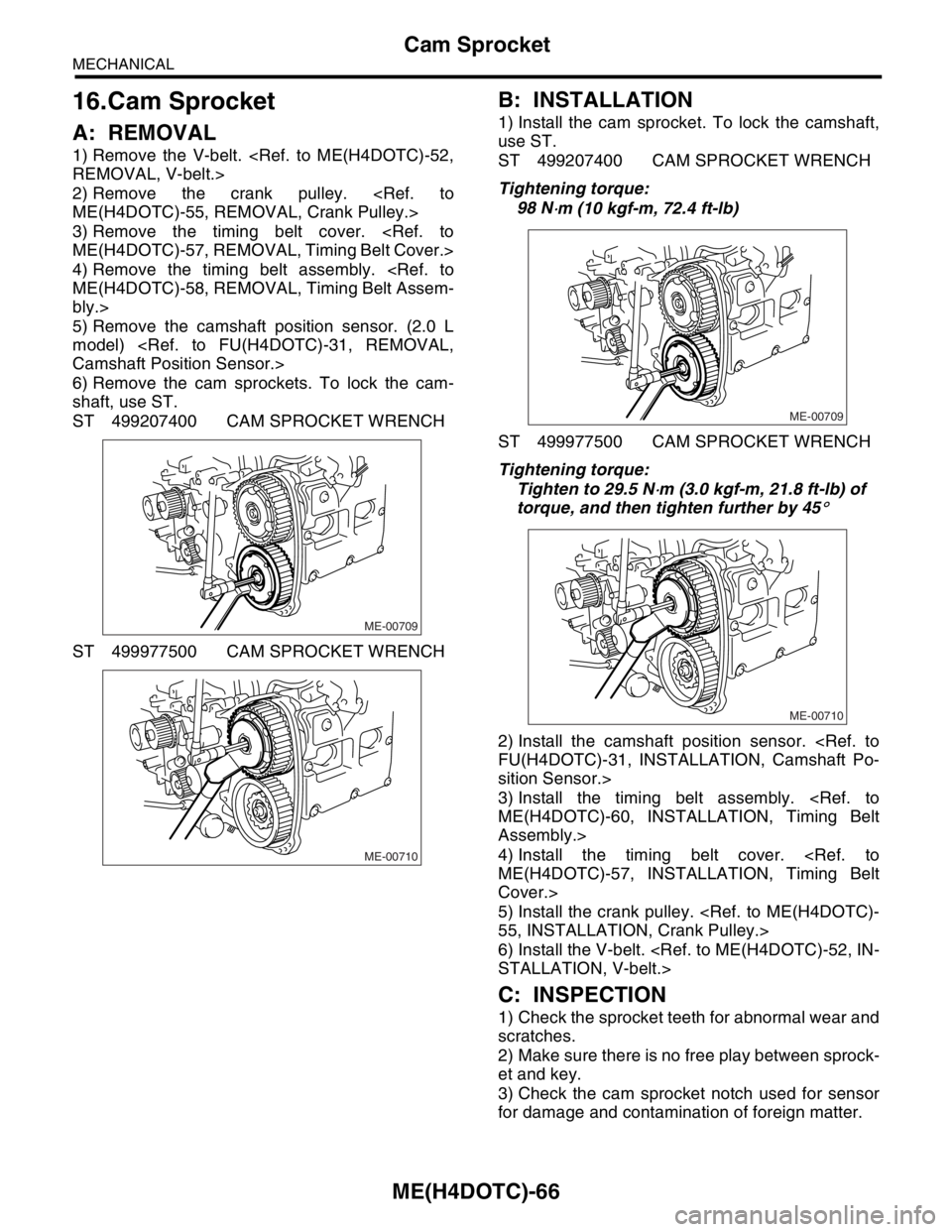
ME(H4DOTC)-66
MECHANICAL
Cam Sprocket
16.Cam Sprocket
A: REMOVAL
1) Remove the V-belt.
REMOVAL, V-belt.>
2) Remove the crank pulley.
ME(H4DOTC)-55, REMOVAL, Crank Pulley.>
3) Remove the timing belt cover.
ME(H4DOTC)-57, REMOVAL, Timing Belt Cover.>
4) Remove the timing belt assembly.
ME(H4DOTC)-58, REMOVAL, Timing Belt Assem-
bly.>
5) Remove the camshaft position sensor. (2.0 L
model)
Camshaft Position Sensor.>
6) Remove the cam sprockets. To lock the cam-
shaft, use ST.
ST 499207400 CAM SPROCKET WRENCH
ST 499977500 CAM SPROCKET WRENCH
B: INSTALLATION
1) Install the cam sprocket. To lock the camshaft,
use ST.
ST 499207400 CAM SPROCKET WRENCH
Tightening torque:
98 N
⋅m (10 kgf-m, 72.4 ft-lb)
ST 499977500 CAM SPROCKET WRENCH
Tightening torque:
Tighten to 29.5 N
⋅m (3.0 kgf-m, 21.8 ft-lb) of
torque, and then tighten further by 45
°
2) Install the camshaft position sensor.
FU(H4DOTC)-31, INSTALLATION, Camshaft Po-
sition Sensor.>
3) Install the timing belt assembly.
ME(H4DOTC)-60, INSTALLATION, Timing Belt
Assembly.>
4) Install the timing belt cover.
ME(H4DOTC)-57, INSTALLATION, Timing Belt
Cover.>
5) Install the crank pulley.
55, INSTALLATION, Crank Pulley.>
6) Install the V-belt.
STALLATION, V-belt.>
C: INSPECTION
1) Check the sprocket teeth for abnormal wear and
scratches.
2) Make sure there is no free play between sprock-
et and key.
3) Check the cam sprocket notch used for sensor
for damage and contamination of foreign matter.
ME-00709
ME-00710
ME-00709
ME-00710
Page 1525 of 2870
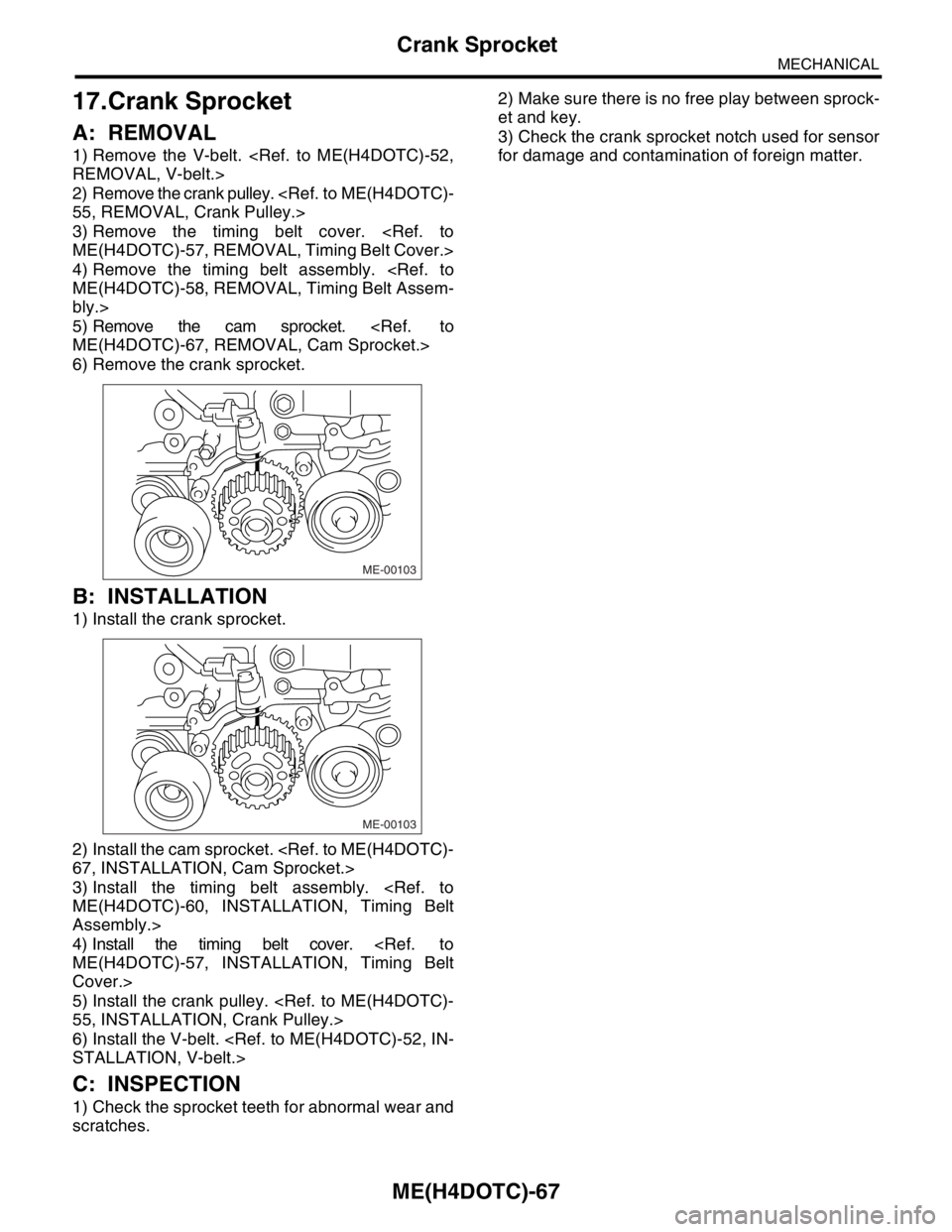
ME(H4DOTC)-67
MECHANICAL
Crank Sprocket
17.Crank Sprocket
A: REMOVAL
1) Remove the V-belt.
REMOVAL, V-belt.>
2) Remove the crank pulley.
55, REMOVAL, Crank Pulley.>
3) Remove the timing belt cover.
ME(H4DOTC)-57, REMOVAL, Timing Belt Cover.>
4) Remove the timing belt assembly.
ME(H4DOTC)-58, REMOVAL, Timing Belt Assem-
bly.>
5) Remove the cam sprocket.
ME(H4DOTC)-67, REMOVAL, Cam Sprocket.>
6) Remove the crank sprocket.
B: INSTALLATION
1) Install the crank sprocket.
2) Install the cam sprocket.
67, INSTALLATION, Cam Sprocket.>
3) Install the timing belt assembly.
ME(H4DOTC)-60, INSTALLATION, Timing Belt
Assembly.>
4) Install the timing belt cover.
ME(H4DOTC)-57, INSTALLATION, Timing Belt
Cover.>
5) Install the crank pulley.
55, INSTALLATION, Crank Pulley.>
6) Install the V-belt.
STALLATION, V-belt.>
C: INSPECTION
1) Check the sprocket teeth for abnormal wear and
scratches.2) Make sure there is no free play between sprock-
et and key.
3) Check the crank sprocket notch used for sensor
for damage and contamination of foreign matter.
ME-00103
ME-00103